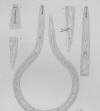|

Female:
-
Body straight to slightly arcuate in fixed specimens,
tapering at both ends, 0.65-0.99 mm long..
-
Annules
distinct, coarse, 2 µm wide near midbody.
-
Lateral
fields not areolated, about 1/4 as wide as
body behind neck region, marked by 4 incisures.
-
Deirids
absent; phasmids
prominent in both sexes, anterior to middle of tail, in neotype female
on 5th and 8th annules behind anus.
-
Lip region hemispherical, offset, exhibiting 5 (rarely
4 or 6) annules; labial sclerotization prominent towards basal plate
and cheilostom.
-
Stylet well developed, with large anteriorly-cupped
basal knobs; tapering portion being non-tubular and needle-like in its
anterior two-fifths.
-
Orifice of dorsal esophageal gland about 2 µm from
spear base.
-
Median esophageal bulb large, oval; basal bulb
elongate-pyriform, with intestine joining its base slightly ventrally;
esophago-intestinal valve (cardiac
valve) prominent.
-
Excretory
pore near base of
isthmus, just behind
hemizonid
which is 1-2 annules long.
-
Sinuous, convoluted canals present in the intestinal
region.
-
Ovaries outstretched with oocytes usually in single
row.
-
Spermathecae
rounded, usually with sperm.
-
Tail elongate-conoid, with unstriated, smoothly
rounded distal end; intestine not extending into tail cavity.
Male:
-
Body length 0.67-1.0 mm.
-
Abundant.
-
Spicules
about 22 µm long, slightly arcuate, with large ventral flanges
distally.
-
Gubernaculum
12 µm long, protrusible, its distal half enlarged with raised sides,
proximal end anteriorly curved or crescent-shaped.
[Ref: CIH Descriptions of Plant-parasitic Nematodes,
Set 1, No. 7 (1972)]
|